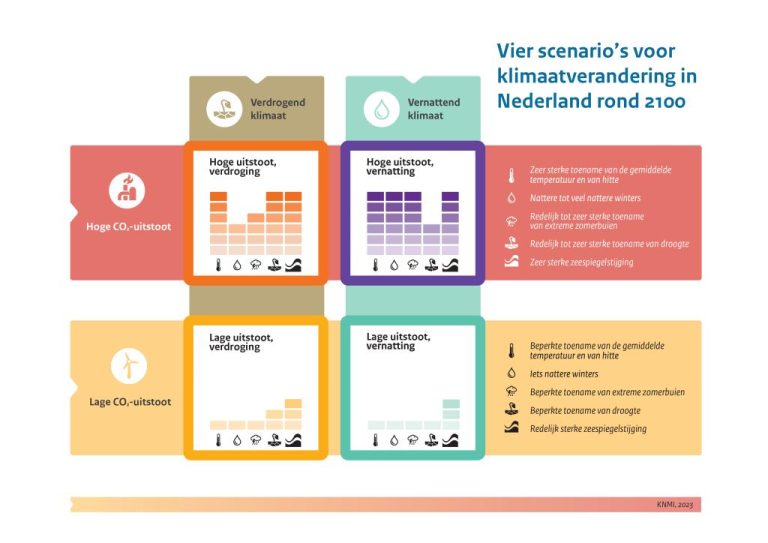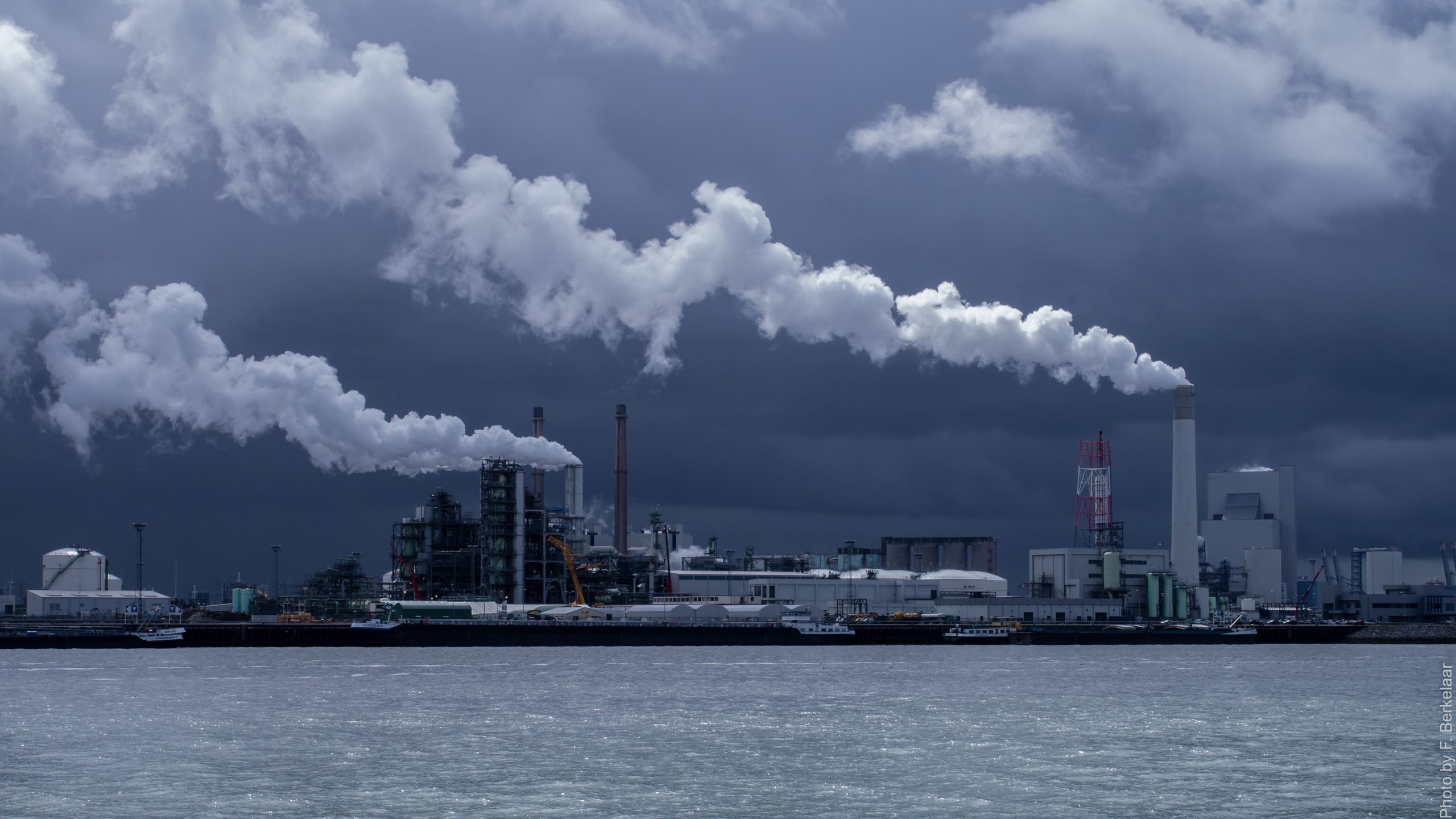The KNMI presented new Dutch climate scenarios on Monday. TU Delft climate scientist Herman Russchenberg and KNMI researcher Sybren Drijfhout: “Extremes determine livability.”
The Maasvlakte near Rotterdam. (Photo: Frans Berkelaar via Pxhere.com)
The Netherlands is getting warmer, with drier summers and wetter winters and has to be prepared for more extremes. This is what emerges from the four new climate scenarios that the KNMI (Royal Netherlands Meteorological Institute) presented at its head office in De Bilt on Monday. The researchers say that climate change in the Netherlands will fall within these parameters.
The KNMI bases its climate scenarios (in Dutch) on the most recent reports of the IPCC (Intergovernmental Panel on Climate Change). Along with the IPCC, the KNMI emphasises the need to reduce greenhouse gas emissions as quickly as possible. ‘The higher the emissions, the greater the warming and the more extreme the weather. Furthermore, the chance of unpredictable consequences increases with every ton of emissions’, the Meteorological Institute states in the report (in Dutch). The previous series of scenarios (in Dutch) date back to 2014.
‘I believe it is wise to assume the worst’
For the first time, the KNMI also examined the chance of drought on top of emissions and greenhouse gases, says researcher Sybren Drijfhout who worked on the new scenarios. “This is very important for the policymakers who use our scenarios. In the Netherlands, water management is our most important and most expensive task.”
Drought
While it is clear that the Netherlands needs to be prepared for drier summers and wetter winters, there is still a large margin of uncertainty in both the driest and the wettest scenarios. “The models vary on how dry or wet the Netherlands will be. It will be somewhere within the parameters that we describe.”
Herman Russchenberg, Professor of Atmospheric Research and Chair of the Climate Action Programme at TU Delft, is pleased that drought is an important issue for the KNMI. “Drought has long been an overlooked issue, while both extreme precipitation and extreme drought are already happening. Just look at the floods in Limburg last year and the drought this summer. We must start preparing now.”
 The four climate scenarios as modelled by the KNMI. On the x axis it distinguishes a drier (in gold) and wetter (in green) climate, on the y axis it distinguishes high emissions (in red) and low emissions (in yellow). The symbols indicate what would be the consequences in each scenario. The more blocks are stacked, the more impact. (Image: KNMI)
The four climate scenarios as modelled by the KNMI. On the x axis it distinguishes a drier (in gold) and wetter (in green) climate, on the y axis it distinguishes high emissions (in red) and low emissions (in yellow). The symbols indicate what would be the consequences in each scenario. The more blocks are stacked, the more impact. (Image: KNMI)
High and low scenario
The KNMI looks at emissions in the four scenarios, just as it did in 2014. In the low scenario this is limited to the agreements made in the Paris Climate Agreement. In the high scenario, the analysis is based on a world where no precautions are taken and the greenhouse gas emissions continue to rise unabated. The IPCC deems the last scenario in particular as highly unlikely.
Nevertheless, Russchenberg believes the KNMI is doing the right thing by choosing the high emission scenario. “As there is still a lot of uncertainty in climate models, I believe it is wise to assume the worst so you can prepare for it. It emphasises the urgency.”
‘Melting permafrost is not or only partially included in the climate models’
In doing so, he primarily thinks about extremes. “It is unlikely that the entire extreme scenario will happen. But even if we do not reach that point, we will still have to deal with extremes. If you assume a more tempered scenario, you will miss the extremes.” KNMI researcher Drijfhout agrees. “No one faces problems in average weather. It is the extremes that determine whether your environment is liveable or not.”
He also says that there are other good reasons to take emissions as the starting point. “Biophysical feedback like melting permafrost or reduced CO2 absorption by the oceans are either not included at all or only partially included in the climate models. Equally, human emissions may actually rise. What will happen if Trump becomes President again and Australia continues to rely on coal? (in Dutch).”
Sea level
Another major uncertainty covered in the report concerns sea level rise. While the highest emissions scenario will cause a rise of ‘only’ six metres, the graphic in the report also shows a rise of at least 17.5 metres by 2300.
“It is really hard to model what will happen to ice caps and oceans. We included this with a large margin of uncertainty. A high sea level rise, however uncertain, could have a huge impact, and certainly for the Netherlands. It is definitely a worst case scenario, but geology shows us that it may happen.”
The KNMI’s scenarios are intended to inform policymakers on all areas where climate may play a role. Russchenberg says that the scientific research at TU Delft is ‘one level below’ the KNMI research. “The Climate Action Programme tries to understand the regional influences in the Netherlands.” TU Delft’s research underpins climate scenarios such as those of the KNMI and will ultimately help refine any further series of scenarios.
‘No other country has so much to gain and so much to lose’
As an example, Russchenberg cites extreme rainfall. “Standard physics shows that one degree of temperature rise would lead to a 7% increase in precipitation. But in practice, this is much more. This is just one of the processes that we need to better understand to further refine the models.”
Taking the lead
While the scenarios show a wide range of eventualities and uncertainties, Drijfhout believes that the message is clear. “We need to ask ourselves if we are not heading towards making large areas of the Netherlands uninhabitable. The report emphasises the need for the Netherlands to take the lead in reducing emissions. No other country has so much to gain and so much to lose.”



Comments are closed.